
Flint is the largest city and seat of Genesee County, Michigan, United States. Located along the Flint River, 66 miles (106 km) northwest of Detroit, it is a principal city within the region known as Mid Michigan. At the 2020 census, Flint had a population of 81,252, making it the twelfth largest city in Michigan. The Flint metropolitan area is located entirely within Genesee County. It is the fourth largest metropolitan area in Michigan with a population of 406,892 in 2020. The city was incorporated in 1855.

Genesee County is a county in the U.S. state of Michigan. As of the 2020 Census, the population was 406,211, making it the fifth-most populous county in Michigan. The county seat and population center is Flint. Genesee County is considered to be a part of the greater Mid Michigan area.
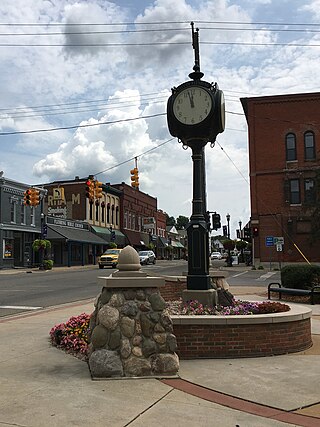
Flushing is a city in Genesee County, Michigan, United States. The population was 8,411 at the 2020 census. Flushing is considered a suburb of Flint. It is situated within the survey area of Flushing Charter Township, but is administratively autonomous.
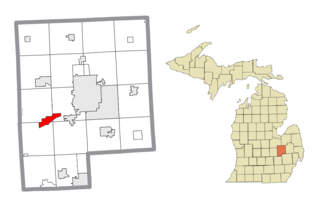
Swartz Creek is a city in Genesee County in the U.S. state of Michigan. The population was 5,897 at the 2020 census. The city is a suburb of Flint and has incorporated land formerly within Flint Charter Township, Gaines Township, and Clayton Township, but is administratively autonomous from all three.

Kettering University is a private university in Flint, Michigan. It offers bachelor of science and master’s degrees in STEM and business fields. Kettering University undergraduate students are required to complete at least five co-op terms to graduate. Students gain paid work experience in a variety of industries with Kettering's more than 550 corporate partners, and graduate with professional experiences accompanying their degree.

Atwood Stadium is an 11,000-seat stadium owned by Kettering University. It's located in the historic Carriage Town district area of downtown Flint, Michigan. In 2019 it became the home field for the Flint City Bucks, a soccer club that competes in USL League Two, as well as Powers Catholic High School. The annual Vehicle City Gridiron Classic also opens the high school football season at Atwood Stadium, with six to eight teams competing each season. The Flint Institute of Music hosts an annual Independence Day concert in the stadium, which is coordinated with Flint's fireworks display, which is launched from the Chevy Commons park, located to the south immediately across the Flint River from the stadium.

The Flint River is a 78.3-mile-long (126.0 km) river in the Flint/Tri-Cities region of Michigan in the United States. The river's headwaters are in Columbiaville in Lapeer County and flows through the counties of Lapeer, Genesee, and Saginaw. The cities of Lapeer, Flint, Flushing, and Montrose are along its course.
Flint Engine Operations is a General Motors automobile engine factory in Flint, Michigan. The plant opened in 2002 and is named to replace the Flint North engine plant. The plant currently produces the small four-cylinder SGE and Duramax I6 engines. The factory receives cast engine blocks from Defiance Foundry in Defiance, Ohio and Saginaw Metal Casting Operations in Saginaw, Michigan. It replaced Flint North.
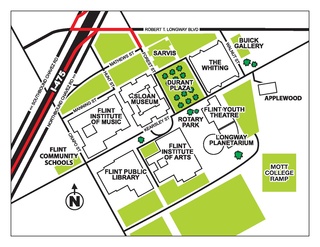
The Flint Cultural Center (FCC) is a campus of cultural, scientific, and artistic institutes located in Flint, Michigan, United States. The institutions located on the grounds of the FCC are the Flint Institute of Arts, Flint Institute of Music, Sloan Museum, Flint Public Library, Buick Gallery & Research Center, Robert T. Longway Planetarium, The Whiting, and the Bower Theatre. The campus and some institutions are owned by Flint Cultural Center Corporation.
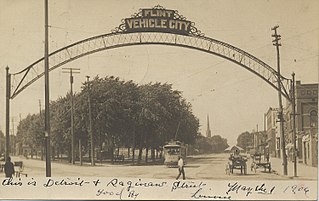
Flint, Michigan is a city which previously relied on its automotive industry, and still does to an extent. Over the past several decades, General Motors plants in Genesee County have experienced re-namings, management shifts, openings, closures, reopenings, and spinoffs.
The Crim Festival of Races is an annual road running event with several races and walking events. The original distance was 10 miles and is the marque race as "The Crim" with its infamous Bradley Hills and blue line to keep runners on course. The Crim has been held in August in Flint, Michigan since 1977. It draws runners from around the world from countries such as Kenya, Russia, and Ukraine. The race attracts approximately 50,000 people each year. The festival is one of the Flint Parade of Festivals.

Dayne Walling is an American politician who was the mayor of Flint, Michigan from 2009 to 2015. Although the Flint mayor's office is a nonpartisan position, Walling is a member of the Democratic Party.

The Mass Transportation Authority (MTA) is the public transit operator serving Flint, Michigan and surrounding Genesee County. It also owns and operates the inter-modal Flint station, which also serves Amtrak and Indian Trails.
Patricia A. Lockwood is an American politician.

Summerset at Frick Park is a residential development located in the Squirrel Hill and Swisshelm Park neighborhoods within the City of Pittsburgh and Allegheny County. This project is one of the nation's first brownfield sites to be remediated for residential purposes. The $250 million public-project began in 1997 and is the City of Pittsburgh's largest residential development since World War II. At completion, Summerset at Frick Park will have over 700 residences and its annual property tax revenue is anticipated to be in the range of $5.7 million to $6.3 million.
Karegnondi Water Authority (KWA) is a municipal corporation responsible for distributing water services in the Mid-Michigan and Thumb areas of the U.S. state of Michigan. Members of the authority are the cities of Flint and Lapeer, and the counties of Genesee, Lapeer and Sanilac. Karegnondi is a word from the Petan Indian language meaning "lake" and another early name for Lake Huron.
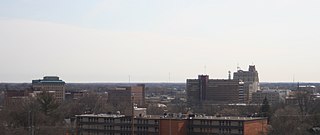
The Flint water crisis was a public health crisis that started in 2014 after the drinking water for the city of Flint, Michigan was contaminated with lead and possibly Legionella bacteria. In April 2014, during a financial crisis, state-appointed emergency manager Darnell Earley changed Flint's water source from the Detroit Water and Sewerage Department to the Flint River. Residents complained about the taste, smell, and appearance of the water. Officials failed to apply corrosion inhibitors to the water, which resulted in lead from aging pipes leaching into the water supply, exposing around 100,000 residents to elevated lead levels. A pair of scientific studies confirmed that lead contamination was present in the water supply. The city switched back to the Detroit water system on October 16, 2015. It later signed a 30-year contract with the new Great Lakes Water Authority (GLWA) on November 22, 2017.

The Genesee County Savings Bank is an office building located at 352 South Saginaw Street in Flint, Michigan. It was listed on the National Register of Historic Places in 2017.

Sheldon A. Neeley is an American politician, currently serving as the Mayor of Flint, Michigan. He was elected as Flint’s mayor in 2019 and served an abbreviated three-year term before being re-elected in 2022. Neeley is a registered Democrat and a former state representative in Michigan's 34th House district. He served two complete terms and one partial term in the Michigan House of Representatives between 2015 and 2019. He resigned from his position in the House when he was elected as the Mayor of Flint in 2019. Neeley's wife, Cynthia, was elected to his former seat on March 10, 2020. Neeley served two complete terms and one partial term on the Flint City Council between 2005 and 2014, prior to his tenure as Michigan Representative and was the Council's first African-American member to have come from Flint's Sixth Ward.


















